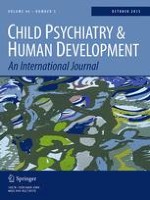11-11-2014 | Original Article
Parental Anxiety Prospectively Predicts Fearful Children’s Physiological Recovery from Stress
Gepubliceerd in: Child Psychiatry & Human Development | Uitgave 5/2015
Log in om toegang te krijgenAbstract
Parental anxiety confers risk for the development of an anxiety disorder in children, and this risk may be transmitted through children’s stress reactivity. Further, some children may be more vulnerable to reactivity in the presence of parent factors such as anxiety. In this study, we examined whether parents’ anxiety symptoms prospectively predict school-aged children’s physiological reactivity following stress, assessed through their electrodermal activity (galvanic skin response) during recovery from a performance challenge task, and whether this varies as a function of children’s temperamental fearfulness. Parents and their children (N = 68) reported on their anxiety symptoms at Time 1 of data collection, and parents characterized the extent to which their children had fearful temperaments. At Time 2 children completed the performance challenge and two recovery tasks. Greater parental anxiety symptom severity at Time 1 predicted children’s higher electrodermal response during both recovery tasks following the failure task. Further, these effects are specific to children with medium and high fearful temperament, whereas for children low in fearfulness, the association between parent anxiety and child reactivity is not significant. Findings provide additional evidence for the diathesis–stress hypothesis and are discussed in terms of their contribution to the literature on developmental psychopathology.
